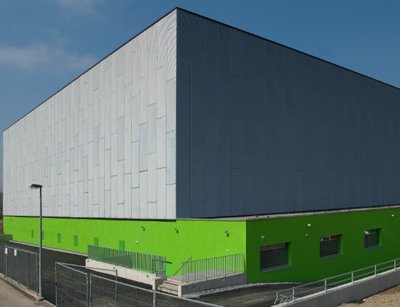In Switzerland, just outside Zurich, a company started by a group of farmers is hoping to revolutionize the relationship between electricity and the data center. It has announced the first commercial application of 380V DC power running throughout the entire data center.
The technology put in place at Green Datacenter removes the need for Uninterruptible Power Supply (UPS) systems, freeing up space and reducing loss of energy during the transmission process. It also removes the need for traditional transformers, used to convert energy coming into the data center from battery rooms and diesel generators. Overall, Green CH says this contributes to its low PUE of 1.4.
No colocation customers have signed up for DC power supply yet (Green still offers traditional AC power as the data center was originally designed for this). Green’s first use of DC has been as a test bed – set up for its Phase 1, 3,300 sq m, facility which can hold 950-1,100 IT racks. HP, which runs some of its cloud services from Green’s new West Zurich data center, will soon, however, switch to DC. Other customers have the option to follow.
Two more phases are planned for the data center, which uses free cooling, as well as a separate office block which will eventually be warmed by excess data center heat. Once complete, the data center will provide 10,000 sq m of space, and will have cost Green CHF100m. It will also be the largest data center in the country.
Green set up its new DC power supply with the help of Swiss power transmission provider ABB and HP, which took the process a step further, creating modular DC transmitters for servers – traditionally it only did these for the telecommunications space. Eventually, HP said its entire product range will come with the option of a 380V modular transmitter, but for now it is running a rack in Green’s West Zurich data center containing HP DL385 servers, HP BladeSystem c3000 and HP x1800 G2 Network Storage.
HP VP of Infrastructure, Industry Standard Servers Ron Noblett says nothing inside the boxes themselves have changed. “We’ve moved a very modular and common connection from a power perspective. Today in our Gen-8 systems we are able to deliver many power interfaces for the exact same IT. So if we deploy a server in Japan at 100V, here at 240V or in the US at 110V, that is the same compute running the same software,” Noblett says.
AC to DC
Green spent an additional CHF8m to take on the DC technology, but CEO Franz Gruter says he expects to see that returned in three years through new clients wins through competitive pricing, space savings and lower power, cooling, infrastructure and maintenance costs.
This is how the system works. In a typical AC environment, power will come into the Green data center at 1,600V and then be converted by the UPS to 400V AC. In the new layout, AC power comes in and is converted using an ABB-designed Rectifier and Transmitter which sits in one small room, where it can transmit in both directions. The Rectifier and Transmitter also connects directly to the battery and diesel generators – removing the need for current to be converted in separate transmitters for each.
ABB Executive VP for the Low Voltage Products Division Tarak Mehta, in Zurich fresh from meeting with Thomas & Betts – its newly acquired subsidiary – said ABB has been working in the high voltage (HV) transmission space for some time with industrial manufacturing and utility clients. Now the company will design HV semiconductors (which can switch the current from AC to DC or DC to AC) for the data center industry.
“The more numbers of transformation [of electricity from AC to DC] you have, the greater the loss of energy,” Mehta says. Green says DC technology can reduce loses along the entire flow of its energy chain by up to 20% – ABB guarantees 10%.
The project did create its challenges for Green, which has done remarkably well for a data center infrastructure service provider given it started off as an agricultural association. (Green moved into data centers after the group’s CEO took a liking to modems and had them installed throughout its membership before carriers pushed the technology out. Eventually it became Internet Service Provider). It originally installed the traditional AC power supply at its data center and had to find room to accommodate extra DC cables. But being a pioneer, according to Green, has been worth the effort.
This article first appeared in FOCUS magazine, issue 22. To sign up for digital editions of FOCUS, click here.

